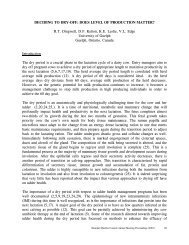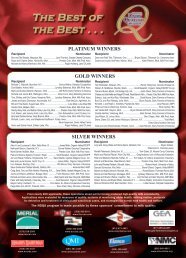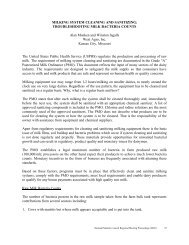round table discussion - National Mastitis Council
round table discussion - National Mastitis Council
round table discussion - National Mastitis Council
You also want an ePaper? Increase the reach of your titles
YUMPU automatically turns print PDFs into web optimized ePapers that Google loves.
As repeat winners, the Dellar family maintains milk quality success in their<br />
herd with over 30,000 pounds (a 3,000-pound jump from last year’s winning<br />
application) of production from 200 milking cows. Ryan and Charina Dellar are<br />
pictured with their children, Gavin and Carmen, near their Harrisville, Mich.,<br />
facility. This year, Dellar Dairy lowered its somatic cell count from 53,000 to<br />
43,333 as a 12-month average. Cattle are housed in a sand-bedded free stall<br />
barn where alleys are scraped three times per day — during each milking. The<br />
herd is milked in a double-10 parallel parlor. “Ryan and Charisa pay close attention<br />
to even the finest details while constantly researching and implementing<br />
innovative ideas,” says nominator Preston Cole with Michigan Milk.<br />
to provide good stimulation and thoroughly dry<br />
them. Then we wait 60 to 90 seconds for good milk<br />
letdown before attaching the milking unit. We also<br />
use silicone liners, changed regularly, and check<br />
pulsation rates regularly. We use cloth towels.<br />
MSU: We work closely with our milking equipment<br />
dealer to insure equipment is functioning<br />
properly and use good teat dips.<br />
True: We like an emollient in predip and postdip,<br />
use auto take-offs, routinely monitor vacuum<br />
pressure, do frequent liner changes and switch to<br />
our winter dip in October.<br />
How do you keep cows comfor<strong>table</strong>?<br />
Beattie: Alleys are scraped twice daily and<br />
stalls are raked once a day. Fresh sand is put<br />
in once per week. Bedded-pack cows are bedded<br />
twice a day with chopped straw. Waterers are<br />
cleaned every other day except in summer months<br />
when they get cleaned daily.<br />
Davenport: We use kiln-dried pine sawdust at<br />
0.5 cubic foot per tie stall per day with 2 ounces<br />
of hydrated lime on foam mattresses. Manure is<br />
scraped by hand at least six times per day, continuously<br />
during milking. We open our barn and<br />
turn on overhead fans during warm weather. Our<br />
barn is closed with eave inlets and a thermostatically<br />
controlled fan when below 30°F.<br />
Dellar: Sand-bedded free stalls are raked every<br />
day, and manure is kicked out at every milking. Alleys<br />
are scraped three times a day at each milking.<br />
New bedding is put in every five to six days. Waterers<br />
are cleaned weekly. We also use tarps/side curtains<br />
and fans to accommodate weather conditions.<br />
Kartes: We have a four-row head-to-head free<br />
stall barn with a feed alley through the center.<br />
We run a one cow per stall capacity at the max,<br />
so overcrowding is never an issue. Our free stalls<br />
are bedded with beach sand every two weeks. Our<br />
barn also has 14-foot sidewalls with curtains all<br />
the way from top to bottom for optimum ventilation.<br />
The barn is completely scraped twice daily<br />
at milking times, and all personnel carry a sand<br />
rake when bringing cows to the parlor. Also, any<br />
sand is leveled flat in stalls at this time.<br />
MSU: Gel mats and pasture mats are scraped<br />
and rebedded twice a day. Comfor<strong>table</strong> bedding<br />
includes putting down hydrated lime, then kiln<br />
dried sawdust.<br />
True: Sand-bedded stalls are groomed each day<br />
and get more sand twice a week. At each milking,<br />
62nd Annual HOARD’S DAIRYMAN ROUND TABLE<br />
we clean out the backs of the stalls and scrape alleys.<br />
We also monitor neck rails and free stalls to<br />
make sure the measurements are correct.<br />
each pen has its own sprinklers, plus the holding<br />
area has a soaker. The pens and holding area<br />
have 60-inch fans which enhance the natural ventilation.<br />
We have curtains for inclement weather.<br />
We use foot baths on the exit alley of the parlor<br />
and rubber belting in all feed alleys. Feed pushup<br />
occurs 12 times per day.<br />
How do you detect subclinical cases?<br />
Beattie: DhI hot sheet and CMT.<br />
Davenport: CMT screening or DhI high SCC<br />
cow list.<br />
Dellar: CMT paddle and PortaSCC strips along<br />
with our DhI hot sheet.<br />
Kartes: We CMT paddle all fresh and dry-off<br />
cows. Also watch milk weights and conductivity<br />
reports daily.<br />
MSU: DhI hot sheet, DeLaval cell counter and<br />
CMT paddle.<br />
True: Monthly DhI SCC testing and CMT testing<br />
on suspicious quarters.<br />
How do you detect clinical mastitis?<br />
Beattie: Forestripping, udder abnormalities, cow<br />
behavior and CMT.<br />
Davenport: Strip cup, backed up with CMT.<br />
Dellar: Prestripping in addition to observing<br />
udders and cow appearance.<br />
Kartes: Prestrip every cow, visually check every<br />
cow after milking for abnormal quarters.<br />
MSU: Stripping as part of milking procedures.<br />
True: Forestripping, low production, CMT testing<br />
and watch for abnormal udder appearance.<br />
Describe your fresh-cow monitoring.<br />
Beattie: We monitor each cow closely by checking<br />
milk, body temperature and udder swelling.<br />
We use the CMT on third milking and treat any<br />
positive quarters with Spectramast LC.<br />
Davenport: All fresh cows are CMTed, and<br />
prefresh cows are checked visibly for swollen<br />
quarters or teat damage. For any high counts not<br />
attributed to colostrum, we culture and use the<br />
quarter milker until results are obtained. Since<br />
it is often no growth, any more clinical signs are<br />
cultured but treated with an over-the-counter<br />
broad spectrum lactating remedy.<br />
Dellar: DhI monthly hot sheet, CMT paddle<br />
An 87,000 SCC put Circle K Farms in the 2012 <strong>National</strong> Dairy Quality Awards<br />
winners’ circle. Their farm currently has 250 Holstein cows that are milked in<br />
a double-16 parallel parlor. In the parlor, milking technicians wear gloves and<br />
follow a written protocol, with five of the six milkers being family members.<br />
The Kartes’ parlor records daily milk weights and uses conductivity to detect<br />
mastitis. Circle K is owned by Brad and Debby Kartes and achieves 24,000<br />
pounds of milk per cow in West Branch, Mich. In addition to the low SCC, the<br />
farm’s standard plate count averaged 1,170 in the 12-month period of the application.<br />
Pictured are (Back, L to R) Cole, Brad, Debbie and Keith. (Front, L to<br />
R) Tucker, Adysen, Lauren, holding Duke; Heather and Hayden Kartes.<br />
and PortaSCC strips. We CMT paddle each cow on<br />
the fifth milking. If the CMT is good, we pull individual<br />
quarter samples and run the PortaSCC on<br />
each quarter. When all quarters are below 50,000,<br />
the cow’s milk enters the tank. If the CMT is bad, a<br />
sample is taken and a culture is performed on farm.<br />
Kartes: We milk all fresh cows in the bucket<br />
for six days, then we CMT paddle all quarters. We<br />
have to get a negative result in all quarters before<br />
that cow’s milk goes in the bulk tank. We also<br />
heavily prestrip and watch daily milk weights<br />
and conductivity levels. If we get a positive, we<br />
will on-farm culture that cow and treat her with a<br />
lactation therapy according to the pathogen.<br />
MSU: After a negative Delvo test for antibiotics,<br />
we check SCC with a DeLaval cell counter.<br />
True: We use visual monitoring of colostrum<br />
and forestripping at freshening. Otherwise, we<br />
use monthly SCC testing by DhI, forestripping to<br />
monitor for mastitis and vet-established mastitis<br />
treatment protocols. We do routine bulk tank culturing<br />
for mastitis pathogens. Treated cows are<br />
milked in a separate flat parlor.<br />
What steps do you take at dry-off?<br />
Beattie: Cows are taken off TMR, fed dry hay<br />
and milked once a day for five to seven days to lower<br />
their milk production, then at dry-off day, they are<br />
administered with Albadry Plus, then Orbeseal.<br />
Cows are in a bedded-pack barn that is sawdust<br />
bedded. They have access to a dirt lot for exercise.<br />
The barn is bedded two times per week and cleaned<br />
once a week. Two to three weeks prior to calving, the<br />
cows get moved to a comfor<strong>table</strong> straw pack barn.<br />
Davenport: Dry cows are isolated from the milking<br />
string and fed free-choice 58 NDF grass hay and<br />
water. We milk them once daily until production is<br />
less than 20 pounds per day. To dry teat, we swab<br />
each teat end with an alcohol pad and simultaneously<br />
inject one tube of Quartermaster while massaging<br />
the quarter. That is followed with a tube of<br />
Orbeseal, postdip and a shot of Triangle 10.<br />
Cows have access to grass pasture for all but<br />
the worst weather. When inside, we use 56 to 58<br />
NDF grass haylage and minerals with refusals to<br />
30-day prefresh cows and heifers.<br />
Dellar: A Spectramast DC tube is used in each<br />
quarter followed by Orbeseal teat sealant. J-5 vaccine<br />
is given at dry-off and one to two weeks before<br />
calving. We also monitor the last DhIA score.<br />
continued on following page<br />
HOARD’S DAIRYMAN<br />
January 10, 2013 23





